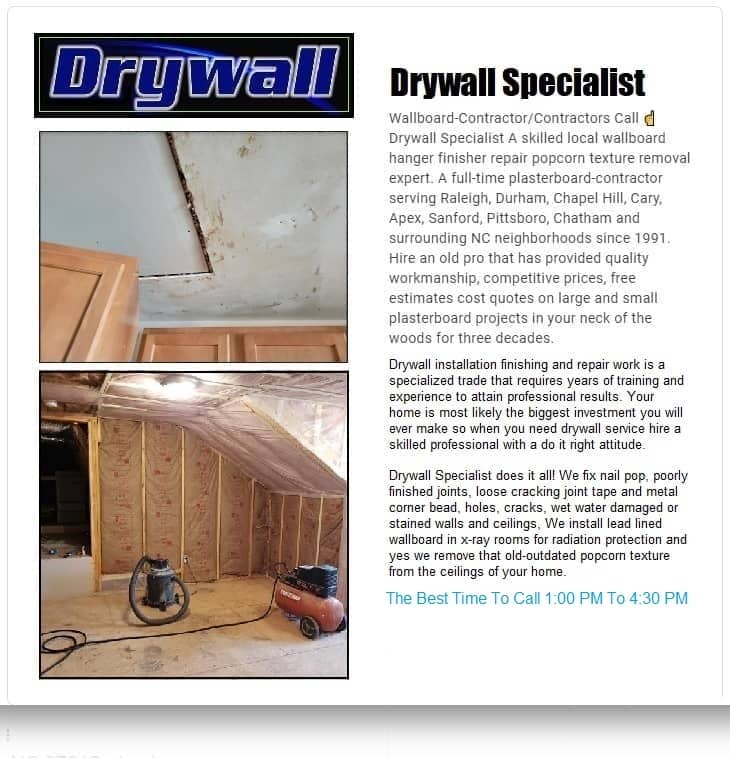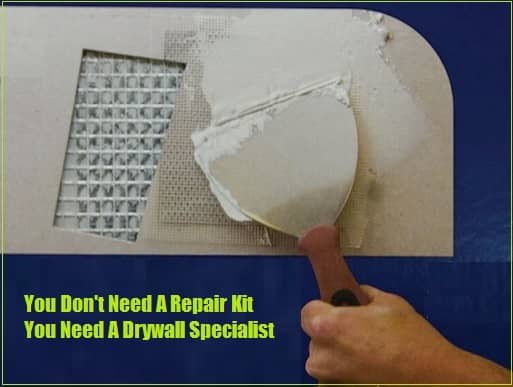
Photo: VIA Drywall Specialist
Drywall is a strong however it's not invencible. Over time,wallboard walls and ceilings can sustain ugly settlement cracks or holes cut by electricians or plumbers. Fortunately, we can fix them all. Fixing drywall like an old pro requires years of training and practice. You can spend hours of time trying to do the repairs yourself only to find they simply don't look the way they should once painted. Save yourself some greef aggravation, call a professional drywall contractor right-now.
We Use Only Namebrand Materials And Supplies.
When repairing minor scratches or dents smaller than ½ inch across, we fill them with a thin layer of joint compound (also known as drywall mud). Apply using a 3- to 4-inch mud knife made for repairing drywall—rather than, say, the kind of narrow utility knife you’d use for wood putty—smoothing the filler till it’s flush with the wall. Cracks or holes larger than ½ inch require fiberglass mesh tape be applied prior to mud work. We never apply joint compound directly to large gouges, the damage will reappear in a matter of days as the house settles and the joint compound dries and crumbles.
DON’T waste time patching drywall call Drywall Specialist.
Your time is valuable so it's allways best when your budget will allow to hire a skilled local drywaller to do the dirty work for you.
Drywall Specialist always leaves the work area clean.
The first thing Drywall Specialist does when starting a new wallboard project is throughly cover floors, furniture and walls if necessary. When the job is completed we leve the work area as clean as when we started.
Drywall specialist is very careful not to cut electrical wiring.
Photo: VIA Drywall Specialist
We don’t cut into a wall to repair a hole until we verify that electrical cords and plumbing lines aren’t running through the space behind it. If the hole is just a few inches wide, shine a flashlight into it to see what’s there. If you must enlarge the hole, carefully cut horizontally with a drywall saw—but avoid going deeper than an inch. It’s safe to assume that hot wires will be present near an electrical outlet, we don’t bet our life that builders or contractors followed all electrical and plumbing codes. Wires and pipes are often found where they don’t belong.
We keep it light.
Less is generally more when it comes to joint compound. A thin coat is easier to sand, and its less likely to remove too much while sanding and expose the patch. Also, for joint compound to appear flush with the wall near the damage site, “we feather” the mud as it is applied.
We DON’T skimp on sanding after patching holes in drywall.
We don't cut corners on sanding drywall the repair site will be noticeable, so take your time. Once the repaired area is dry, take to it with some fine-grit (100 or 120) sandpaper. After the first round of sanding, add a second layer of mud, spreading it about 2 inches beyond the boundaries of the first layer. Once dry, re-sand your repair.
We protect you by closing off the work area.
The fine particulate of drywall compound could injure your lungs if inhaled. So always put plastic over doors and openings to protect you the home owner when sanding drywall compound. As far as us we ware quality partical mast to protect ourselves.
We cut out and install new drywall on large holes.
When fixing damage that’s larger than a small nail hole, we use a mesh drywall patch to complete the repair. After all to fill the hole with spackle as it will crumble after it dries. Most drywall repair for wall repair need mesh, and we often use a quick setting spackle that is much harder and stronger to do larger repairs.
Drywall Specialist does it all including nail pop.
As a home settles, its framing can twist. This twist motion can push the nails holding the drywall to the wall studs outward, creating a visible bulge known as nail pops. We could tap that nail head back in with a hammer, however it would eventually work its way back out again. So we remove and repalace it with a drywall screw for a more permanent fix. The screws will hold the drywall to the wall stud, preventing it from shifting and pushing the nail back out. Once the screws are in place, use drywall spackle to cover up the holes.
Drywall Specialist replaces loose cracking metal corner bead.
In addition to nail pops, a settling house can also cause the corner drywall bead to buckle, crack, and separate. If the wall corner was made with paper-faced corner bead, we simply cut out the damaged area using a utility knife and replace the paper tape. We glue, crimp and screw the new corner bead and mud with quickset for a stronger longer lasting repair.
The estimate Drywall Specialist gives is exactly what you will pay unless additional work is added.
Drywall repair prices can vary greatly form one wallboard contractor to another. It’s important to understand how much more it will cost than doing the job yourself. Drywall Specialist charges $195 to repair and return to sand small holes up to 4 inches in diameter, according to Drywall Specialist. Expect to pay between $200 and $550 to repair 2 to 8 holes and cracks in a single room. Fixing drywall isn't a DIY project and should be left to a professional Sheetrock contractor.
We use furring strips when applying a large drywall patch.
Drywall Specialist uses furring strips when fixing a hole in drywall that is more than 6 inches wide requires you to use furring strips to provide adequate support to ensure the repair holds up. We begin by cutting a piece of furring strip that’s 4 inches longer than the hole. We drive a drywall screw halfway into the center of the strip. Holding the strip by the screw head, place it inside the hole. Position the furring strip so that the drywall overlaps it on either side. While holding the furring strip in place, drive several screws through the drywall into the furring strip so that it’s secured in place. Next, we attach the new piece of drywall to the furring strip using drywall screws.
We use drywall tape to prevent messy seams.
Photo: VIA Drywall Specialist
Many drywallers cut corners by failing to use drywall tape when mudding seams. Drywall tape helps hold the joint compound in place, preventing it from sagging as it dries or cracking and crumbling out of the seam over time. There are several styles of drywall tape we use. While most pros use paper tape because they can apply it quickly and it offers the smoothest finish, it can be difficult to work with. While it doesn’t offer the same finish, self-adhesive tape is stronger so it's what we use. When repairing drywall in bathrooms, basements and other areas exposed to high humidity, use moisture-resistant tape.
When taking on a larger repair that involves cutting out a section of drywall or adding furring strips, it’s a good idea to locate the wall studs before you begin. Utilities, including your home’s electrical wiring and plumbing, run along the studs in the wall of the home. Identify the stud locations before cutting or applying fasteners to a section of drywall to avoid coming into contact with wires or pipes. If you’re repairing nail pops, identifying the stud is easy. Simply use a level, line it up vertically along the nail pop and draw a line with a pencil to identify the stud’s location. If there are no visible nail heads in the wall, use a stud finder.
We DON’T forget to inspect.
Drywall is a strong however it's not invencible. Over time,wallboard walls and ceilings can sustain ugly settlement cracks or holes cut by electricians or plumbers. Fortunately, we can fix them all. Fixing drywall like an old pro requires years of training and practice. You can spend hours of time trying to do the repairs yourself only to find they simply don't look the way they should once painted. Save yourself some greef aggravation, call a professional drywall contractor right-now.
We Use Only Namebrand Materials And Supplies.
When repairing minor scratches or dents smaller than ½ inch across, we fill them with a thin layer of joint compound (also known as drywall mud). Apply using a 3- to 4-inch mud knife made for repairing drywall—rather than, say, the kind of narrow utility knife you’d use for wood putty—smoothing the filler till it’s flush with the wall. Cracks or holes larger than ½ inch require fiberglass mesh tape be applied prior to mud work. We never apply joint compound directly to large gouges, the damage will reappear in a matter of days as the house settles and the joint compound dries and crumbles.
DON’T waste time patching drywall call Drywall Specialist.
Your time is valuable so it's allways best when your budget will allow to hire a skilled local drywaller to do the dirty work for you.
Drywall Specialist always leaves the work area clean.
The first thing Drywall Specialist does when starting a new wallboard project is throughly cover floors, furniture and walls if necessary. When the job is completed we leve the work area as clean as when we started.
Drywall specialist is very careful not to cut electrical wiring.
Drywall Specialist locatee wall studs before starting a repair.
When taking on a larger repair that involves cutting out a section of drywall or adding furring strips, we locate the wall studs before we begin. Utilities, including your home’s electrical wiring and plumbing, run along the studs in the wall of the home. We identify the stud locations before cutting or applying fasteners to a section of drywall to avoid coming into contact with wires or pipes. If we’re repairing nail pops, identifying the stud is easy. We simply use a level, line it up vertically along the nail pop and draw a line with a pencil to identify the stud’s location. If there are no visible nail heads in the wall, use a stud finder.
We inspect each and every repair with a 500 watt work light.
Think were done? Not so fast! We run hands over the repair to ensure that it feels smooth. Then, with our temple against the wall, use a 500 watt work light look for humps that might need more sanding.
Once we’re satisfied with the look and feel of the patch job, we then prime and paint the area. No one will ever know the hole or crack existed!




Comments
Post a Comment